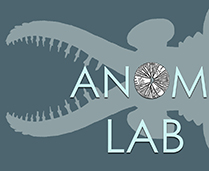In an article published today in Biology Letters, AnomLab postdoc Pierre Gueriau and his collaborators have resolved an 80-year-old mystery by deciphering the true nature of a 400-million-year-old marine creature from Germany. Since its initial description in 1943, this fossil, named Gilsonicaris rhenanus, has perplexed scientists who have alternatively interpreted it as an anostracan crustacean (‘fairy or brine shrimp’), a myriapod, or even a part of a starfish arm. Using a 3D X-ray scanner, the team reveals that Gilsonicaris is, in fact, a polychaete annelid (‘bristle worm’). This discovery unequivocally dismisses the existence of marine anostracans 400 million years ago, while also offering a wealth of new information regarding the early evolutionary history of bristle worms and their soft tissues.
A 3D model that can be manipulated at will is available on Sketchfab.
Reference: Gueriau P., Parry L.A. & Rabet N. 2023. Gilsonicaris from the Lower Devonian Hunsrück slate is a eunicidan annelid and not the oldest crown anostracan crustacean. Biology Letters 19: 20230312. Find the article (Open Access) here.
